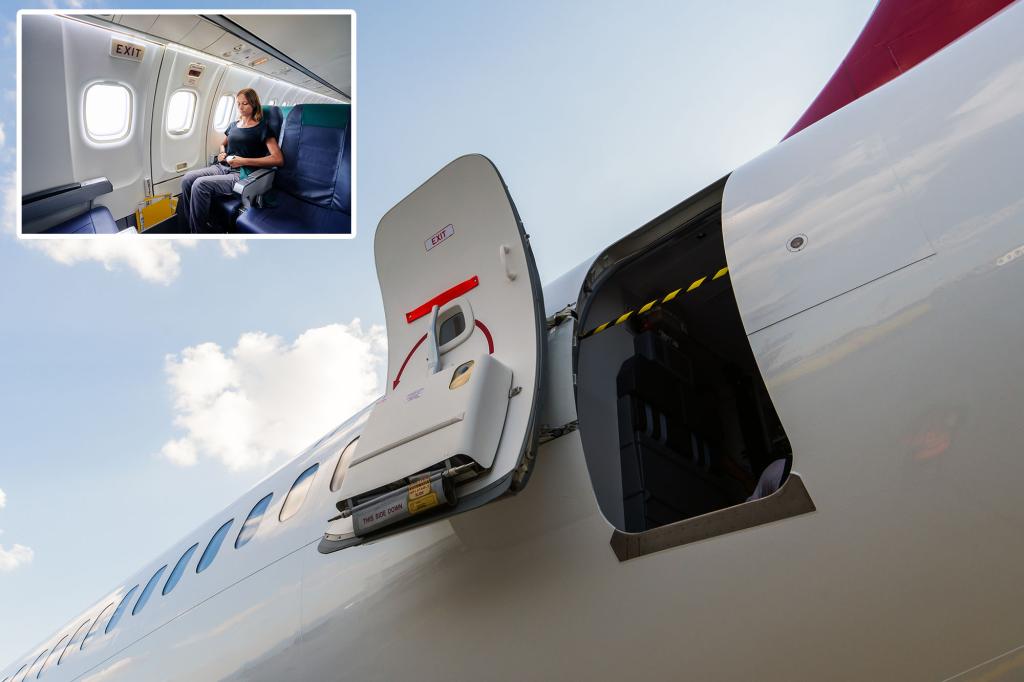Is it opening the door to disaster?
Bum-rushing the emergency exit on a plane has seemingly become a go-to move among those looking to make trouble at 30,000 feet. Now, air experts are weighing in on what happens when mile-high hellions attempt to activate the doorway to heaven — and the outcome is not so good.
Dan Bubb, Ph.D., a former airline pilot and current aviation safety expert, explained that opening the emergency exit — which he noted is for evacuations — on the ground will cause the door to open and an inflatable slide to deploy, Reader’s Digest reported.
That is because the air pressure in both the cabin and outside is equal, thereby allowing passengers to disengage the locking mechanism.
While generally activated by a flight attendant during an emergency, the escape chute has notably been deployed by bozo passengers and crew members during non-emergencies as well.
In December, a flight in Spain had to be evacuated after a panicky male passenger released the emergency slide while the plane was idling on the runway in stifling heat.
A month later, a bumbling British Airways crew member cost the airline $122,000 after accidentally deploying the safety ramp.
And in perhaps the most infamous example in 2010, then-JetBlue flight attendant Steven Slater announced he was quitting, grabbed two beers from the drinks cart, opened the door and disappeared down the slide.
But what happens when someone tries to pull the same trick in the sky? Absolutely nothing.
That phenomenon is due to the high pressure differential between the inside and outside of the aircraft — which effectively seals the plug-style doors in place.
“The air pressure inside of the plane is much greater than the pressure outside of the plane,” explained Budd. “This makes it exceedingly difficult to open the door.”
American Airlines First Officer Steve Scheibner explained that to open the emergency door midflight, one would need to be able to lift 25,000 pounds, Travel + Leisure magazine reported.
“Once this door gets pressurized in flight, it’s nine pounds per square inch,” the flyboy — who goes by Captain Steeeve on TikTok — said.
If someone did manage to breach the hatch inflight, “it would create a decompression situation where the oxygen masks would fall from the ceiling, and the pilot would have to put the plane in a dive to an altitude of 14,000 feet within four minutes,” Bubb explained.
Also preventing a midair evacuation is the door’s locking mechanism, which engages on the runway when the airplane has attained a speed of 92 miles per hour, according to Scheibner.
It’s then virtually impossible to manually unlock the door until the aircraft slows down again.
Coincidentally, the Federal Aviation Administration started requiring passenger aircraft to come equipped with this safety mechanism in 1972 in response to a spate of airplane hijackings in the 1960s and 1970s.
However, that safeguard hasn’t stopped bozos from attempting to monkey with the airlock inflight.
Last month, an out-of-control passenger aboard a flight from Tokyo to Houston allegedly tried to open a cabin door midair, forcing panicked travelers to restrain him as the plane made an emergency landing.
Despite the difficulty of budging the seemingly impregnable sky portal, at least one passenger appears to have succeeded.
In 2023, an Asiana Airlines passenger opened an emergency door moments before the plane landed in Daegu, South Korea, sparking panic among the 194 flyers in the wind-swept cabin.
Thankfully, the plane was able to touch down safely, and no one was seriously injured, although a dozen were taken to the hospital and treated for hyperventilation.
Geoffrey Thomas, an aviation expert with Airline Ratings, described the incident as “very bizarre” because “technically, it’s not possible to open those doors in flight.”
In most cases, attempting to open the escape hatch can result in a flight diversion and the arrest of the passenger responsible.
In 2024, a flight attendant broke their leg while attempting to restrain a passenger who attempted to open a door midflight. In light of the crewmember’s injury, the man was charged with a federal crime, and, if convicted, could face 20 years in prison.
At the very least, those attempting an unauthorized evacuation will likely earn themselves a nonstop trip onto a no-fly list.
Read the full article here







